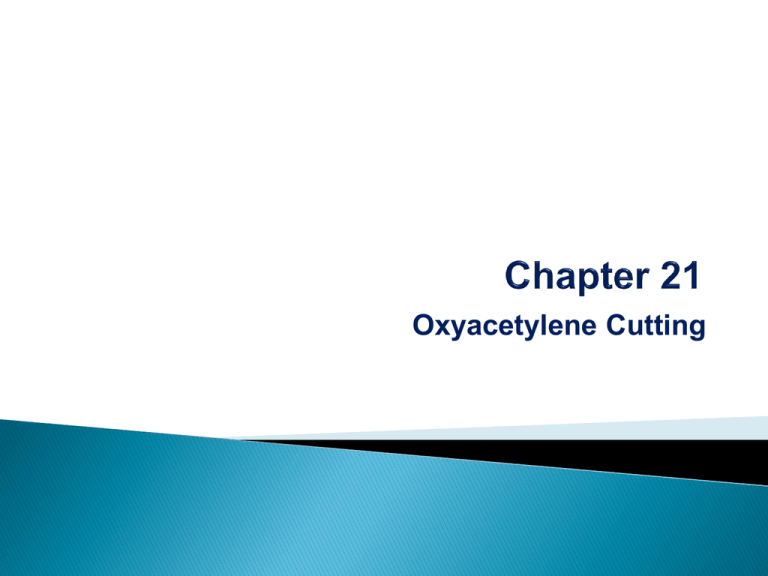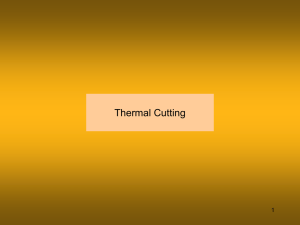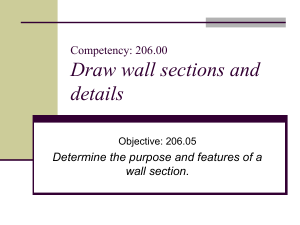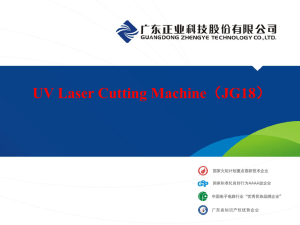to the Chapter 21 - Oxyacetylene Cutting
advertisement

Oxyacetylene Cutting After completing this chapter, you will be able to: ◦ Demonstrate the proper and safe method of setting up cylinders, regulators, hoses, and the cutting torch ◦ Demonstrate how to maintain a cutting tip and torch ◦ Demonstrate how to light a torch, adjust it, and make a cut ◦ Describe a good oxyacetylene cut ◦ Discuss safety procedures to be followed when oxyfuel cutting Chapter #21 – Oxyacetylene Cutting Primary cutting process in oxyfuel gas cutting (OFC) ◦ Uses heat from oxygen fuel gas flame Raises metal temperature to kindling temperature High-pressure stream of oxygen is directed onto the metal, causing it to be cut (rapidly oxidized) ◦ Processes are identified by fuel type mixed with oxygen to produce the preheat flame Chapter #21 – Oxyacetylene Cutting Table 21-1 Fuel Gases Used for Flame Cutting A B FIGURE 21-1 (A) Oxyacetylene portable cutting rig mounted on a handcart for use in a shop area. (B) Oxyacetylene setup mounted on a trailer for use outside of a shop. Larry Jeffus Chapter #21 – Oxyacetylene Cutting Oxyfuel gas cutting ◦ Used to cut iron base alloys (ferrous metals) ◦ Low carbon steels (up to 0.3% carbon) Easy to cut ◦ High nickel steels, cast iron, and stainless steel Considered uncuttable with OFC-A ◦ Nonferrous metals (e.g., brass, copper, and aluminum) Cannot be cut by oxyacetylene cutting Chapter #21 – Oxyacetylene Cutting Chapter #21 – Oxyacetylene Cutting Chapter #21 – Oxyacetylene Cutting Chapter #21 – Oxyacetylene Cutting 1) GOGGLES (shade 4-6) 2) GLOVES 3) PROTECTIVE CLOTHING Chapter #21 – Oxyacetylene Cutting 1) Working area must be clear of unnecessary items 2) Protect yourself and others from flying sparks 3) Support and balance the metal being cut 4) Clear space underneath the cut 5) Use proper technique in starting a cut Chapter #21 – Oxyacetylene Cutting Oxyacetylene hand torch ◦ Most common oxyfuel gas cutting torch Most cutting tips are made of copper alloy, but some tips are chrome FIGURE 21-2 Oxyfuel cutting torch. Thermadyne Industries, Inc Chapter #21 – Oxyacetylene Cutting FIGURE 21-4 A mixing chamber located in the tip. American Welding Society FIGURE 21-5 Injector mixing torch. American Welding Society Chapter #21 – Oxyacetylene Cutting FIGURE 21-7 Different manufacturers have differently designed cutting torch tip seats. Larry Jeffus Chapter #21 – Oxyacetylene Cutting Other Gases Acetylene THE CUTTING TIP Preheat Flame Holes Cutting Oxygen Hole Chapter #21 – Oxyacetylene Cutting Exactly like setting up oxyfuel welding equipment ◦ Except for adjustment of gas pressures Refer to Chapter #21 of the text Greater detail and practice will take place in shop Chapter #21 – Oxyacetylene Cutting Proper alignment of preheat holes will speed up and improve the cut FIGURE 21-19 Tip alignment for a square cut. American Welding Society FIGURE 21-20 Tip alignment for a bevel cut. American Welding Society Chapter #21 – Oxyacetylene Cutting Laying out a line ◦ Done with soapstone or a chalk line ◦ Scribe or a punch can be used FIGURE 21-22 Holding the punch slightly above the surface allows the punch to be struck rapidly and moved along a line to mark it for cutting. Larry Jeffus Chapter #21 – Oxyacetylene Cutting Tips size selection: ◦ Designated by manufacturer numbering system ◦ Refer to manufacturer’s recommendation chart ◦ Size needed is determine by “material thickness” ◦ Pressure are then selected from chart Chapter #21 – Oxyacetylene Cutting Table 21-6 Cutting Pressure and Tip Size Chapter #21 – Oxyacetylene Cutting Oxyfuel gas cutting torch ◦ Metal cut rapidly oxidizes or burns High-pressure stream of oxygen is directed on metal preheated above kindling point ◦ Burning away of metal is a chemical reaction with iron (Fe) and oxygen (O) Oxygen forms an iron oxide Heat is produced by metal as it burns Chapter #21 – Oxyacetylene Cutting THE WELDING TORCH OXYGEN VALVE MUST BE WIDE OPEN Chapter #21 – Oxyacetylene Cutting THE HIGHER OXYGEN PRESSURE WILL CAUSE THE OXYGEN TO BACK UP THE ACETYLENE HOSE, CAUSING A HIGHLY EXPLOSIVE GAS TO COLLECT IN THE ACETYLENE HOSE Chapter #21 – Oxyacetylene Cutting PRESS THE CUTTING OXYGEN VALVE Chapter #21 – Oxyacetylene Cutting Chapter #21 – Oxyacetylene Cutting THE SPACE LEFT WHEN THE METAL IS CUT Chapter #21 – Oxyacetylene Cutting THE THICKNESS OR DISTANCE OF THE BEVEL 1.4 “ 1” 1” Chapter #21 – Oxyacetylene Cutting MAKE A SMALL GOUGE WITH A COLD CHISEL, HACK SAW OR ZIP CUT Chapter #21 – Oxyacetylene Cutting Oxyacetylene torch ◦ Indispensable tool Speedy Accurate Saves time FIGURE 21-92 Nuts and bolts on this rusty plow could not be taken off without a torch. Larry Jeffus Chapter #21 – Oxyacetylene Cutting Next set of slides deal with flame cutting technique Review if time permits Chapter #21 – Oxyacetylene Cutting Allow better control and even cutting FIGURE 21-38 Using angle irons to aid in making cuts. © Cengage Learning 2012 Chapter #21 – Oxyacetylene Cutting Easier if one side of the metal is scrap ◦ Cut is turned out a short distance into the scrap side No side is scrap ◦ Forward movement should be stopped before releasing cutting lever FIGURE 21-40 Turning out into the scrap to make stopping and starting points smoother. © Cengage Learning 2012 Chapter #21 – Oxyacetylene Cutting Burning a hole in the plate FIGURE 21-59 Sequence for piercing a plate. © Cengage Learning 2012 Chapter #21 – Oxyacetylene Cutting FIGURE 21-83 Small diameter pipe can be cut without changing the angle of the torch. After the top is cut, roll the pipe to cut the bottom. © Cengage Learning 2012 FIGURE 21-84 On large diameter pipe, the torch is turned to keep it at a right angle to the pipe. The pipe should be cut as far as possible before stopping and turning it. © Cengage Learning 2012 Chapter #21 – Oxyacetylene Cutting THE CUT WILL BE CLEAN AND FREE OF SLAG Chapter #21 – Oxyacetylene Cutting THE KERF WILL HAVE A ROUNDED TOP EDGE AND SLAG WILL ADHERE TO THE BOTTOM OF THE CUT Chapter #21 – Oxyacetylene Cutting Chapter #21 – Oxyacetylene Cutting NOT ENOUGH PREHEAT WAS USED Chapter #21 – Oxyacetylene Cutting





